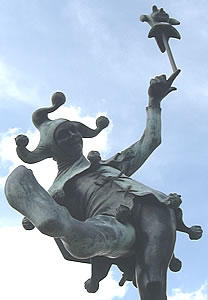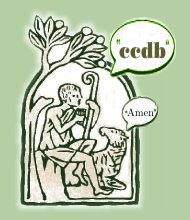Vatican II at Forty
The Catholic Sentinel has the story here. A glimpse of the good stuff:
Dec. 8 marked the anniversary of the close of the council in 1965, and Rome and the Vatican are hosting several commemorative encounters to reflect on how far the church has come over the last four decades.More on the fruits of the council:
Pope Benedict, who participated in the council as a theological expert, is to speak about the importance of the council’s documents. Although he has criticized some postconciliar changes, the pope has made it clear that Vatican II will be the “compass” of his papacy.
The pope also has emphasized that implementation of the council is an ongoing task in the church, not just something that happened 40 years ago. One goal is to make sure Vatican II is not viewed as ancient history by young generations of Catholics.
“Thanks to the council, young people have been taught to see the world not simply as a threat to Christian life, but as an opportunity to announce the Gospel,” Melloni said.
Vatican II is sometimes described as a revolution, but it did not appear out of the blue. There had been 20 previous ecumenical councils in the church’s history, including the First Vatican Council in 1869-70. Vatican I defined the dogmas of papal infallibility and the primacy of papal jurisdiction, but the council was suspended when war broke out in Europe, and it never resumed.
The theological ferment of the mid-20th century helped lay the groundwork for Vatican II. Pioneering theologians like Dominican Father Yves Congar and Jesuit Fathers John Courtney Murray and Henri de Lubac were trying to build bridges between Christianity’s ancient truths and the contemporary world. All three were silenced in some fashion by the Vatican during the 1950s, but re-emerged to become important voices of the council.
Pope John XXIII surprised almost everyone when, after only three months as pontiff, he announced he was convening the council. The pope spoke of the need to update the church and promote Christian unity; above all, he said, he wanted to show the modern world that the church had been transformed and intellectually reinvigorated.
Pope John said the world was marked by spiritual poverty and needed the church’s vitality. But, as he later told the council, the church wanted to offer the modern world the “medicine of mercy” and not severe condemnations.
Preparation for the council took almost three years, and Pope John, already diagnosed with cancer when it began, presided over only the first of four annual autumn sessions in 1962. The invitation to Protestants, Orthodox and other non-Catholics to attend had already made Vatican II a historic event.
Pope Paul VI guided the completion of the council’s work, presiding over the other three sessions and directing the important follow-up work in areas of liturgy, ecumenism, religious life and evangelization.
In the years after its close, the renewal outlined by the council was refined and codified in a number of decrees, norms and changes in canon law. The church witnessed countless changes:The debate rages on, as we in St. Blog's know, from sometimes painful experience.
• The new Roman Missal was issued in 1970, with a new cycle of readings designed to offer a richer selection of Scripture. The liturgical calendar was simplified. The rites for sacraments were revised, emphasizing the communal aspects of their celebration. The Rite of Christian Initiation of Adults was revived and reformed. As the changes took place, active liturgical participation increased dramatically in many local church communities.
• Lay ministries multiplied. Lay readers and lay ministers of Communion appeared during Mass. Laity were represented on parish councils and diocesan boards, and lay men and women, many with theology degrees, replaced clerics in a number of administrative church positions.
• Throughout the church, there was a renewed attention to Scriptures, in liturgy and in individual spirituality.
• Eastern Catholic churches were encouraged to return to their own traditions, ending a period of Latinization and opening a new appreciation of variety within the universal church.
• Ecumenism flourished, in formal dialogue between Catholic officials and other Christian churches, and in prayer and fellowship encounters at the local level.
• After the council acknowledged the possibility of salvation for non-Christians, dialogue also began with other religions.
• Religious life changed dramatically, as religious orders adopted Vatican norms and rewrote their own constitutions, taking a new look at issues of authority, community and identity.
• The council restored the permanent diaconate as a ministry and allowed married men to be ordained deacons. Today, there are more than 29,000 permanent deacons around the world.
• The council’s teaching that the pope and bishops together form a single collegial body led to a new appreciation for bishops and bishops’ conferences. The Synod of Bishops was formed to meet regularly and advise the pope.
• Theology was revitalized, especially moral theology, which focused increasingly on biblical sources and the individual conscience, and less on church law or authority.
• The council underlined the church’s solidarity with humanity instead of its separation from the secular world, and this led to a mushrooming of social and charitable activities. Church leaders spoke frequently about the church’s identification with the poor and suffering, and the pope became a strong human rights advocate.
At the same time, the church experienced some worrisome developments, including a dramatic drop in vocations and an increase in the number of priests and religious seeking laicization. Mass attendance fell in many places, many Catholics abandoned the sacrament of penance, and dissent on certain teachings, such as birth control, was widespread.
All that has helped fuel a 40-year debate over the proper reading and realization of the council.
I never knew the Catholic Church before the Second Vatican Council. I know that every Catholic I've met that went through catechetical formation knew tragically little about their faith. They also experienced horrible abuse and completely inappropriate pastoral ministry. Does this mean I condemn that Catholic Church before the Second Vatican Council? Of course not! The errors of any number of her members does not make the Church a bastion of corruption, doomed to failure. It makes her who she is: A hospital for sinners, who encounter the Great Physician. Well, what's true for the Catholic Church before Vatican II is true for her after. And for the same reason: the imperfection of those that implemented the council does not make the Catholic Church a flawed movement. No, to the extent that she's a communion of imperfect human beings, she's already a flawed movement. But to the extent that she's the divine society established by our Lord and Savior, Jesus Christ, she's the umblemished Bride of Christ. Within her embrace, we enjoy authentic communion with each other and with our Savior!
The Second Vatican Council sought new ways for the Church to carry out her mission in the modern world. The Council's documents provide the Church with the way to speak the modern world's cultural language. This is so that she can best serve the people that need to hear the gospel. The documents were never intended as a way for the world to educate the Church on how to be a more wordly-friendly Bride of Christ. Thus, the dissenters that often invoke the "Spirit of Vatican II" call upon a council that the Vatican II Fathers would not have recognized!
We in the Church have argued the council for forty years. We may argue it for forty more. We'll only make our peace with it when many of us finally accept the council for exactly what it is. If we continue trying to force it to be what we say that it is, then we'll never come close to making our peace with it. Or with each other.





















<< Home